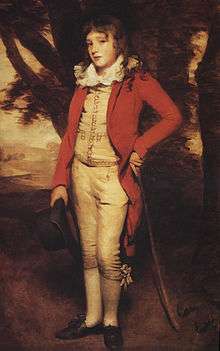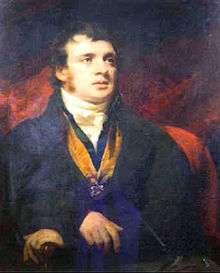Sir George Mackenzie, 7th Baronet
Sir George Steuart Mackenzie, 7th Baronet (1780–1848) was a Scottish mineralogist.



Life
The only son of Major-general Sir Alexander Mackenzie of Coul, by his wife Katharine, daughter of Robert Ramsay of Camno, he was born on 22 June 1780. He succeeded to the baronetcy on the death of his father in 1796. He first became known to the scientific world in 1800, when he claimed a proof of the identity of diamond with carbon by a series of experiments on the formation of steel by the combination of diamonds with iron; in these experiments he is said to have made free use of his mother's jewels. A few years later he became fellow of the Royal Societies of London and Edinburgh.[1]
Pupil and friend of Robert Jameson, Mackenzie devoted much time to the study of mineralogy and geology. His interest in those subjects led him in 1810 to undertake a journey to Iceland, when he was accompanied by Henry Holland and Dr. Richard Bright. To illustrate the conclusions he had formed with regard to the geology of Iceland, Mackenzie visited the Faroe Islands in 1812, and on his return read an account of his observations before the Edinburgh Royal Society.[1]
Mackenzie died in October 1848.[1]
Works
In 1811, Bright, Holland and Mackenzie published Travels in Iceland; Mackenzie contributed the narrative of the voyage and the travels, and the chapters on the mineralogy, rural economy, and commerce of the island. It was favourably reviewed by Robert Southey (Quarterly Review, vii. 48–92).[1] In this book Mackenzie first proposed explanation of periodic eruptions of geyser; he envisaged a geyser plumbing system that includes a large subterranean cavity connected to the ground surface by a highly contorted conduit.[2]
Mackenzie drew up a report for the Board of Agriculture: General View of the Agriculture of Ross and Cromarty, 1813. From 1826 to 1848 he contributed numerous papers to the discussion of the origin of the Parallel Roads of Lochaber, but his views did not gain acceptance. He also wrote:

- Treatise on the Diseases and Management of Sheep. With … an Appendix containing documents exhibiting the value of the merino breed, Inverness, 1807.
- An Essay on some Subjects connected with Taste, Edinburgh, 1817; 2nd edit. 1842.
- Illustrations of Phrenology. With Engravings, Edinburgh, 1820.
- Documents laid before … Lord Glenelg … relative to the Convicts sent to New South Wales, Edinburgh, 1836.
- General Observations on the Principles of Education, &c. Edinburgh, 1836.
- On the most Recent Disturbance of the Crust of the Earth in respect to its Suggesting an Hypothesis to Account for the Origin of Glaciers (Edinb. New Phil. Journ. xxxiii. 1–9).[1]
Family
Mackenzie married, first, 8 June 1802, Mary, fifth daughter of Donald Macleod of Geanies, sheriff of Ross-shire, by whom he had seven sons and three daughters. The fourth son Robert Ramsay Mackenzie became Premier of Queensland.[3] On her death (13 January 1835) he married, secondly, Katharine, second daughter of Sir Henry Jardine of Harwood, and widow of Captain John Street, R.A., by whom he had one son.[1]
References
- 1 2 3 4 5 6 Hewins 1893.
- ↑ [Belousov, A., Belousova, M., Nechayev, A., 2013. Video observations inside conduits of erupting geysers in Kamchatka, Russia, and their geological framework: implications for the geyser mechanism. Geology 41, 387 - 390]
- ↑ Australian Dictionary of Biography, Mackenzie, Sir Robert Ramsay (1811–1873).
- Attribution
![]() This article incorporates text from a publication now in the public domain: Hewins, William Albert Samuel (1893). "Mackenzie, George Steuart". In Lee, Sidney. Dictionary of National Biography 35. London: Smith, Elder & Co.
This article incorporates text from a publication now in the public domain: Hewins, William Albert Samuel (1893). "Mackenzie, George Steuart". In Lee, Sidney. Dictionary of National Biography 35. London: Smith, Elder & Co.
External links
|